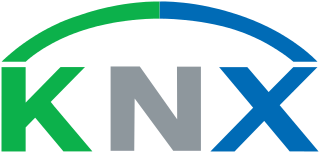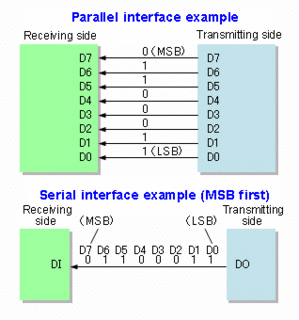
In computer architecture, a bus is a communication system that transfers data between components inside a computer, or between computers. This expression covers all related hardware components and software, including communication protocols.

Universal Serial Bus (USB) is an industry standard that establishes specifications for cables and connectors and protocols for connection, communication and power supply (interfacing) between computers, peripherals and other computers. Released in 1996, the USB standard is currently maintained by the USB Implementers Forum (USB-IF). There have been four generations of USB specifications: USB 1.x, USB 2.0, USB 3.x and USB4.

I²C, pronounced I-squared-C, is a synchronous, multi-master, multi-slave, packet switched, single-ended, serial computer bus invented in 1982 by Philips Semiconductor. It is widely used for attaching lower-speed peripheral ICs to processors and microcontrollers in short-distance, intra-board communication. Alternatively, I²C is spelled I2C or IIC.
HyperTransport (HT), formerly known as Lightning Data Transport (LDT), is a technology for interconnection of computer processors. It is a bidirectional serial/parallel high-bandwidth, low-latency point-to-point link that was introduced on April 2, 2001. The HyperTransport Consortium is in charge of promoting and developing HyperTransport technology.

KNX is an open standard for commercial and domestic building automation. KNX devices can manage lighting, blinds and shutters, HVAC, security systems, energy management, audio video, white goods, displays, remote control, etc. KNX evolved from three earlier standards; the European Home Systems Protocol (EHS), BatiBUS, and the European Installation Bus. It can use twisted pair, powerline, RF, or IP links. On this network, the devices form distributed applications and tight interaction is possible. This is implemented via interworking models with standardised datapoint types and objects, modelling logical device channels.

In telecommunication and data transmission, serial communication is the process of sending data one bit at a time, sequentially, over a communication channel or computer bus. This is in contrast to parallel communication, where several bits are sent as a whole, on a link with several parallel channels.

Electronic test equipment is used to create signals and capture responses from electronic devices under test (DUTs). In this way, the proper operation of the DUT can be proven or faults in the device can be traced. Use of electronic test equipment is essential to any serious work on electronics systems.
The PowerPC 970, PowerPC 970FX, PowerPC 970GX, and PowerPC 970MP are 64-bit PowerPC processors from IBM introduced in 2002. When used in PowerPC-based Macintosh computers, Apple referred to them as the PowerPC G5.

Automatic test equipment or automated test equipment (ATE) is any apparatus that performs tests on a device, known as the device under test (DUT), equipment under test (EUT) or unit under test (UUT), using automation to quickly perform measurements and evaluate the test results. An ATE can be a simple computer-controlled digital multimeter, or a complicated system containing dozens of complex test instruments capable of automatically testing and diagnosing faults in sophisticated electronic packaged parts or on wafer testing, including system on chips and integrated circuits.
The ARM Advanced Microcontroller Bus Architecture (AMBA) is an open-standard, on-chip interconnect specification for the connection and management of functional blocks in system-on-a-chip (SoC) designs. It facilitates development of multi-processor designs with large numbers of controllers and components with a bus architecture. Since its inception, the scope of AMBA has, despite its name, gone far beyond microcontroller devices. Today, AMBA is widely used on a range of ASIC and SoC parts including applications processors used in modern portable mobile devices like smartphones. AMBA is a registered trademark of ARM Ltd.
Digital Addressable Lighting Interface (DALI) is a trademark for network-based products that control lighting. The underlying technology was established by a consortium of lighting equipment manufacturers as a successor for 1-10 V/0–10 V lighting control systems, and as an open standard alternative to several proprietary protocols. The DALI, DALI-2 and D4i trademarks are owned by the lighting industry alliance, DiiA.
The PowerPC 600 family was the first family of PowerPC processors built. They were designed at the Somerset facility in Austin, Texas, jointly funded and staffed by engineers from IBM and Motorola as a part of the AIM alliance. Somerset was opened in 1992 and its goal was to make the first PowerPC processor and then keep designing general purpose PowerPC processors for personal computers. The first incarnation became the PowerPC 601 in 1993, and the second generation soon followed with the PowerPC 603, PowerPC 604 and the 64-bit PowerPC 620.
Tolapai is the code name of Intel's embedded system-on-a-chip (SoC) which combines a Pentium M (Dothan) processor core, DDR2 memory controllers and I/O controllers, and a QuickAssist integrated accelerator unit for security functions.

The Display Serial Interface (DSI) is a specification by the Mobile Industry Processor Interface (MIPI) Alliance aimed at reducing the cost of display controllers in a mobile device. It is commonly targeted at LCD and similar display technologies. It defines a serial bus and a communication protocol between the host, the source of the image data, and the device which is the destination.
MIPI Alliance is a global business alliance that develops technical specifications for the mobile ecosystem, particularly smart phones but including mobile-influenced industries. MIPI was founded in 2003 by ARM, Intel, Nokia, Samsung, STMicroelectronics and Texas Instruments.
The Serial Low-power Inter-chip Media Bus (SLIMbus) is a standard interface between baseband or application processors and peripheral components in mobile terminals. It was developed within the MIPI Alliance, founded by ARM, Nokia, STMicroelectronics and Texas Instruments. The interface supports many digital audio components simultaneously, and carries multiple digital audio data streams at differing sample rates and bit widths.
An embedded controller (EC) is a microcontroller in computers that handles various system tasks that the operating system does not handle.

I3C is a specification to enable communication between computer chips by defining the electrical connection between the chips and signaling patterns to be used. The standard defines the electrical connection between the chips to be a two wire, shared(multidrop), serial data bus, one wire (SCL) being used as a clock to define the sampling times, the other wire (SDA) being used as a data line whose voltage can be sampled. The standard defines a signalling protocol in which multiple chips can control communication and thereby act as the bus master.








